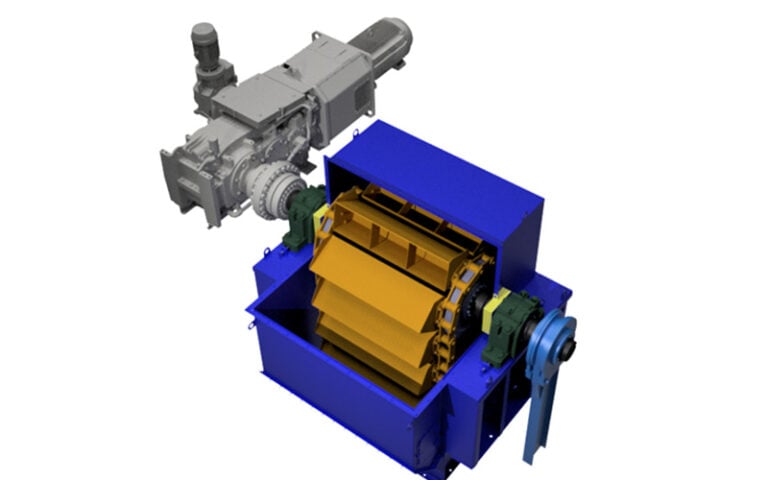Bucket elevators are the equipment of choice when it comes to vertical handling at facilities ranging from mine sites to production plants. Highly customizable and capable of handling a wide range of materials, bucket elevators can quickly and reliably carry any free-flowing material.
The customizability of bucket elevators lends them to a diverse range of handling capacities. In some settings, however, the standard bucket elevator simply can’t meet the capacity requirements necessary at some facilities. When this happens, the super-capacity elevator can be an essential alternative to implementing multiple units.
What is a Super-Capacity Bucket Elevator?
The term “super-capacity” is an industry term denoting a dual-chain continuous bucket elevator. These elevators are available in a range of sizes, with minimum capacity starting around 100 TPH and going all the way up to 800 TPH.
With nominal inside dimensions of 82” wide by 66” deep, FEECO super-capacity elevators fill a critical gap in the market for high-tonnage vertical handling.
Design & Build Considerations
The considerations that go into designing and building a super-capacity elevator are much the same as a standard elevator with a few exceptions.
As with all bucket elevators, the following factors play into the design and build of a super-capacity elevator:
- Discharge height
- Capacity
- Chain speed
- Bulk density
In contrast, the following considerations must also be factored into the design:
Chain Pull
While super-capacity elevators operate on the same mechanics as a standard elevator, the added weight associated with the high tonnages of a super-capacity elevator means the design and construction needs to be a little more robust. This is particularly evident in that chain pull plays a much larger role in the design process of a super-capacity elevator, adding another layer of complexity.
Chain pull is the combined weight of the material, buckets, and chain. While chain pull does play into the design of standard elevators, it is significantly less influential.
In designing a super-capacity elevator, manufacturers must pay careful attention to head shaft size, chain duty, and in the case of self-supporting elevators, casing design.
Head Shaft Size
To counteract chain pull, FEECO employs a few key design modifications. We use larger head shafts, up to 13” in diameter (in comparison, a standard head shaft is typically no larger than 8” in diameter).
Chain Duty
We also utilize a heavier-duty chain, rated for 40,000 lbs. Perhaps the most significant difference is our use of two strands of chain instead of the standard single chain. This helps to carry the extra load by dividing it between two chains. In taking these measures, we can ensure that chain pull does not put added stress on the unit or risk overloading any components.
Casing Design
Chain pull is even more important when it comes to designing self-supporting (self-standing, or in other words, no structural steel for support at the head) elevators, as the casing design must be capable of bearing the unit’s entire weight.
Bucket Elevator Takeup
FEECO also employs an internal gravity-style takeup for super-capacity elevators. This takeup style offers a few key advantages in this setting:
- It is self-tensioning, minimizing human-equipment interaction and oversight.
- It requires little-to-no maintenance.
- The boot shaft does not penetrate the casing, eliminating the potential for material leakage at this point.
Casing Weldments
The larger casing size of the super-capacity elevators provides the opportunity to internally seal weld the inside corners of casings. This is a major advantage when working with corrosive materials, as it prevents moisture and material from building up between the casings and vertical angles, thus eliminating a common point of corrosive wear.
In elevators that use structural steel support at the head, we implement an expansion joint just below the head casing, allowing the elevator to move or expand independently of the structural steel.
Bucket Size
Not surprisingly, the buckets on super-capacity elevators are also larger, allowing them to accommodate the higher tonnages. Elevator buckets are available in sizes up to 56” wide.
In addition to these modifications, we incorporate all of our standard elevator features as well, including:
- Removable top covers
- Access doors for easy maintenance
- Horizontally and vertically heavy-reinforced, jig-welded head, boot, and intermediate sections
- Adjustable throat plate at discharge
- Inspection doors on both sides of discharge
- Service platforms and access ladders available
Applications
Super-capacity elevators are employed in plants looking to handle extremely high tonnages that would otherwise require multiple units to meet handling goals. As such, they are most often used at mine sites and in mineral fertilizer plants. In particular, they have become the industry standard at potash mines.
Potash mines regularly use super-capacity elevators due to the high tonnages characteristic of the industry.
Conclusion
Super-capacity elevators are an ideal option for materials handling extremely high tonnages. While they are similar to standard elevators, they require a few modifications in the design and construction in order to serve as a safe and reliable handling solution at these capacities. This typically includes heavier-duty chains, larger head shafts, bigger buckets, and more.
Trusted since 1951, FEECO is the industry’s most reputable supplier of custom bucket elevators, including super-capacity elevators. In addition to ensuring our super-capacity elevators are designed and manufactured according to stringent quality standards, we also offer extensive customer service and parts support and can replace out-of-production Rexnord bucket elevators.
For more information on our super-capacity bucket elevators or other bulk material handling equipment, contact us today!



